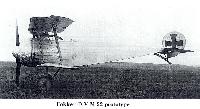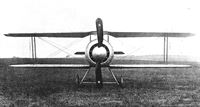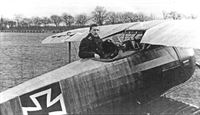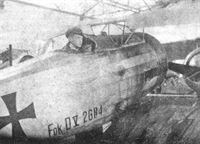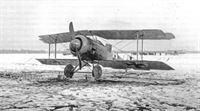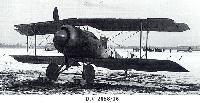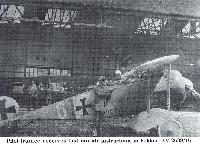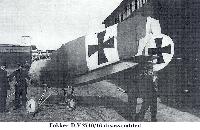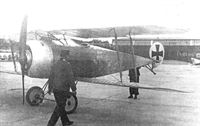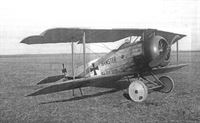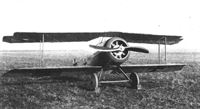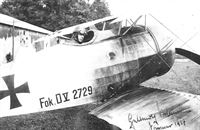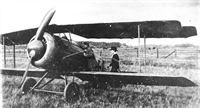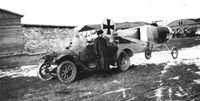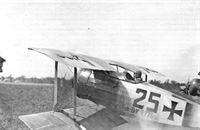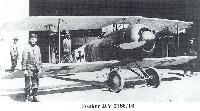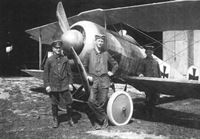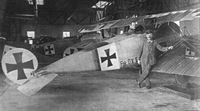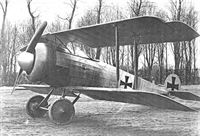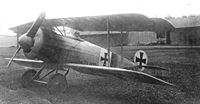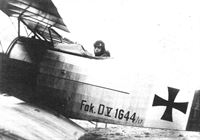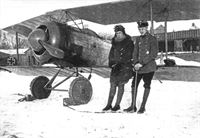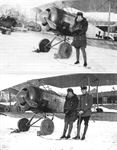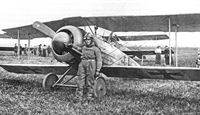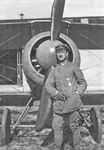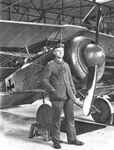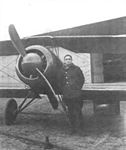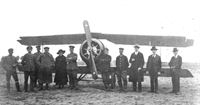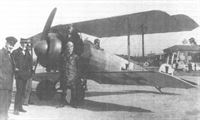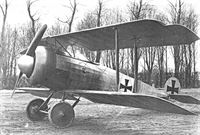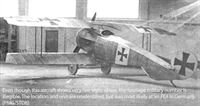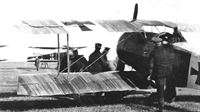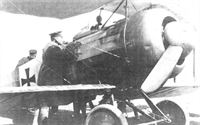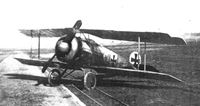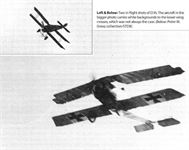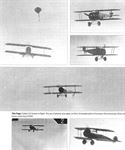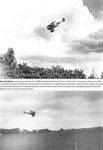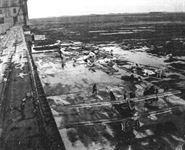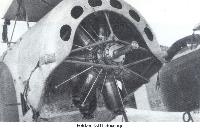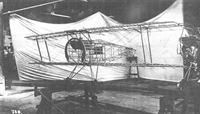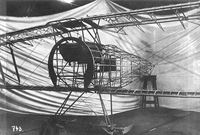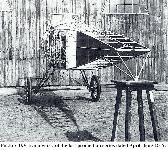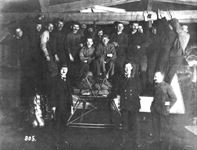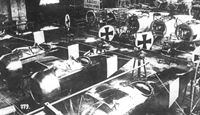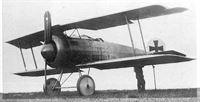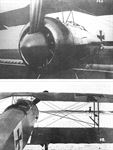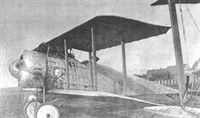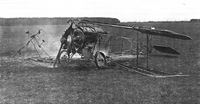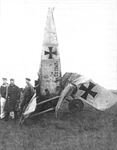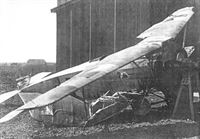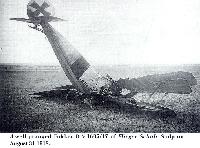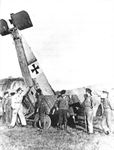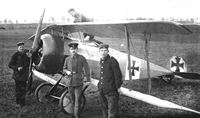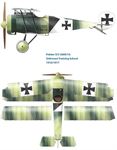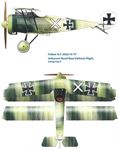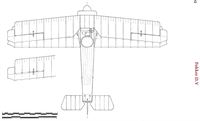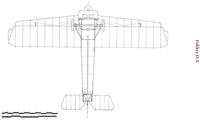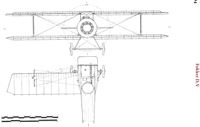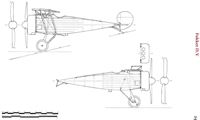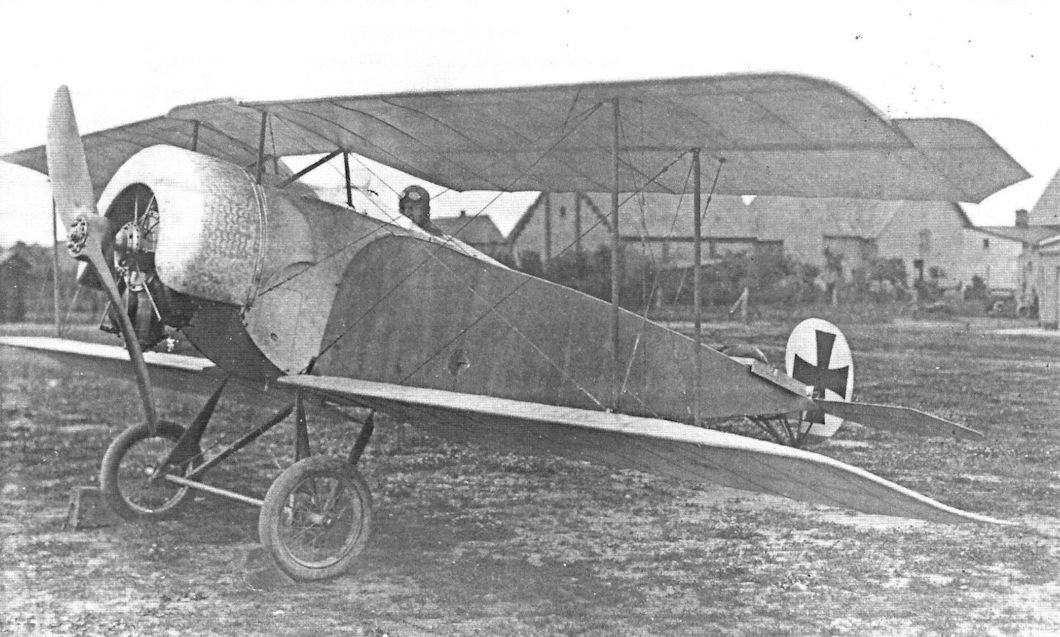
Описание
Страна: Германия
Год: 1916
Истребитель
Варианты
- Fokker - D.II / M.17 - 1916 - Германия
- Fokker - D.III / M.19 - 1916 - Германия
- Fokker - D.V / M.22 - 1916 - Германия
- В.Кондратьев Самолеты первой мировой войны
- A.Weyl Fokker: The Creative Years (Putnam)
- J.Herris, J.Leckscheid Fokker Aircraft of WWI. Vol.3: Early Biplane Fighters (A Centennial Perspective on Great War Airplanes 53)
- O.Thetford, P.Gray German Aircraft of the First World War (Putnam)
- W.Green, G.Swanborough The Complete Book of Fighters
-
J.Herris, J.Leckscheid - Fokker Aircraft of WWI. Vol.3: Early Biplane Fighters /Centennial Perspective/ (53)
Fokker D.V 2669/16, Unknown Training School, 1916/1917
-
J.Herris, J.Leckscheid - Fokker Aircraft of WWI. Vol.3: Early Biplane Fighters /Centennial Perspective/ (53)
Fokker D.V 2682/16 "X", Unknown Naval Base Defense Flight, 1916/1917
-
J.Herris, J.Leckscheid - Fokker Aircraft of WWI. Vol.3: Early Biplane Fighters /Centennial Perspective/ (53)
Fokker D.V 2690/16, Unknown Training Unit, Naval Air Service, Early 1917
-
J.Herris, J.Leckscheid - Fokker Aircraft of WWI. Vol.3: Early Biplane Fighters /Centennial Perspective/ (53)
Fokker D.V 2775/16, Ltn. Hess, Kampf-Einsitzer Schule Warschau, May 1917
-
J.Herris, J.Leckscheid - Fokker Aircraft of WWI. Vol.3: Early Biplane Fighters /Centennial Perspective/ (53)
Fokker D.V 2775/16, "24", Kampf-Einsitzer Schule Warschau, Ltn. Hess, May 1917
-
J.Herris, J.Leckscheid - Fokker Aircraft of WWI. Vol.3: Early Biplane Fighters /Centennial Perspective/ (53)
Fokker D.V 2786/16, Billiken
-
J.Herris, J.Leckscheid - Fokker Aircraft of WWI. Vol.3: Early Biplane Fighters /Centennial Perspective/ (53)
Fokker D.V, Factory camouflage
-
J.Herris, J.Leckscheid - Fokker Aircraft of WWI. Vol.3: Early Biplane Fighters /Centennial Perspective/ (53)
Fokker D.V Habicht, Unknown Fliegerschule, 1917
-
В.Кондратьев - Самолеты первой мировой войны
"Фоккер" D.V германских ВВС, 1917г.
-
J.Herris, J.Leckscheid - Fokker Aircraft of WWI. Vol.3: Early Biplane Fighters /Centennial Perspective/ (53)
Anthony Fokker in the cockpit of an unidentified single-seat, single-bay fighter prototype developed from the D.II. The upper wing is the major difference; it is swept-back with horn-balanced ailerons. The engine is a 100 hp Oberursel U.I. This was almost certainly the first prototype of the M.22 series. (Peter M. Grosz collection/STDB)
-
Сайт - Pilots-and-planes /WWW/
Anthony Fokker in the cockpit of the unidentified single-seat fighter prototype developed from the D.II. The upper wing is the major difference; it is swept-back with horn-balanced ailerons. This was probably the first M.22 prototype. (Peter M. Grosz collection/STDB)
-
J.Herris, J.Leckscheid - Fokker Aircraft of WWI. Vol.3: Early Biplane Fighters /Centennial Perspective/ (53)
An other view of the unidentified single-seat fighter, single-bay prototype developed from the D.II. The upper wing is the major difference; it is swept-back with horn-balanced ailerons. The wing cellule appears essentially that of the production D.V; it differs from the D.V in its fuselage and cowling contours and lack of a spinner.
-
Сайт - Pilots-and-planes /WWW/
Fokker D.V M 22 prototype
-
J.Herris, J.Leckscheid - Fokker Aircraft of WWI. Vol.3: Early Biplane Fighters /Centennial Perspective/ (53)
The swept upper-wing shows well in the side view, as does the longer fuselage, especially when compared to the side view of Werknummer 1068. Both aircraft still lack the three cooling holes on the bottom of the engine cowling seen on later production aircraft.
-
J.Herris, J.Leckscheid - Fokker Aircraft of WWI. Vol.3: Early Biplane Fighters /Centennial Perspective/ (53)
The far more compact and clean appearance of the single-bay D.V, especially when compared to the two-bay D.II, is readily apparent in the frontal view of the prototype. The Garuda airscrew remained the same, though a big spinner has been fitted.
-
J.Herris, J.Leckscheid - Fokker Aircraft of WWI. Vol.3: Early Biplane Fighters /Centennial Perspective/ (53)
Aerodynamically, the D.V was a big step forward compared to the identically-powered D.II. The wooden stringers on the forward fuselage, which resulted in a rounded shape allowing a neat fit of the circular engine cowling, show through the fuselage fabric.
-
J.Herris, J.Leckscheid - Fokker Aircraft of WWI. Vol.3: Early Biplane Fighters /Centennial Perspective/ (53)
The fuselage of the "true" Fokker D.V prototype under assembly at Schwerin. Identical to the Fokker D.I - D.IV, the upper wing center-section was an integral part of the fuselage.The forward landing gear legs were straight rather than being swept forward slightly, as on the production D.V.
-
J.Herris, J.Leckscheid - Fokker Aircraft of WWI. Vol.3: Early Biplane Fighters /Centennial Perspective/ (53)
A pair of unarmed D.V sat Brest-Litowsk. Nearest to the camera is 2651/17, an early-production machine
-
J.Herris, J.Leckscheid - Fokker Aircraft of WWI. Vol.3: Early Biplane Fighters /Centennial Perspective/ (53)
The newly-designed circular engine cowling prevented the forward fuselage of the D.V from suffering from the same amount of staining and wear seen on the D.II and D.III. Yet the lowest of the forward fuselage stringers on D.V 2655/16 has already been stained by castor oil.
D.V 2655/16 seen here was one of the earliest production aircraft to be photographed. The light green paint on the cowling has been applied a bit further towards the rear. Again, the spinner, wheel cover and struts appear to be painted light green, too. The dark green paint has been applied only to the rear third of the engine cowling and the forward fuselage and upper forward fuselage panel. -
J.Herris, J.Leckscheid - Fokker Aircraft of WWI. Vol.3: Early Biplane Fighters /Centennial Perspective/ (53)
Application of the Black (?) and White marking ahead of the fuselage cross lead to the application of the military number 2669/16 above the "Fok. DV" inscription. The ground crew members in the left foreground appear not to be very keen to have their picture taken...
-
J.Herris, J.Leckscheid - Fokker Aircraft of WWI. Vol.3: Early Biplane Fighters /Centennial Perspective/ (53)
Carrying a similar marking to the aircraft above, this is in fact a very different D.V. It is armed with an LMG 08 machine gun and the tip of the spinner has been painted in an unknown color. An addition very rarely seen on a D.V can be seen on the rear interplane struts, where leader's streamers have been attached. Thus this may have been the "personal" plane of the commander of a flying school.
The two-color engine cowling shows well on this unidentified D.V, which carries some rare personal markings, too. Here it seems the wheel covers were painted light.green, while the struts have been painted dark green. Photographs indicate that on the D.V, the strut fairings were not wood brown. They were painted in one of the greens, on some planes possibly even light blue. The metal clamps holding the covers in place were generally of the same color as the wooden strut fairings, indicating that both these items were painted. -
J.Herris, J.Leckscheid - Fokker Aircraft of WWI. Vol.3: Early Biplane Fighters /Centennial Perspective/ (53)
Fokker D.V 2676/16 is set up to have pictures taken with a tripod mounted camera. On frontline aircraft, an Idflieg regulation issued on 29 October 1916 decreed that fuselage and wing crosses were to be applied with a 5 cm wide white border around them. The crewmen of this Naval unit have carried over these instructions to the rudder, too, which was to remain white.
-
J.Herris, J.Leckscheid - Fokker Aircraft of WWI. Vol.3: Early Biplane Fighters /Centennial Perspective/ (53)
One of the photos taken during this occasion allows a close look at the dense streaked camouflage applied to the early-production D.V aircraft. The scalloped fabric covering of the aileron hinge lines is prominently visible in this shot.
Operated by a Naval defense unit, Fokker D.V 2676/16 was an early-production D.V which was finished in the "dark" version of the streaked scheme. The camouflage pattern was applied in a very dense way, both on the wings and fuselage. -
J.Herris, J.Leckscheid - Fokker Aircraft of WWI. Vol.3: Early Biplane Fighters /Centennial Perspective/ (53)
A very grainy photo of unarmed D.V 2684/16 in a well-lit spacious hangar. The exhaust fumes have removed the paint on the below half of the forward fuselage maintenance panel.
-
Сайт - Pilots-and-planes /WWW/
Leutnant Hans Elmenhorst died in the crash of Fokker D.V 2687/16 in May 1917 at Bavarian Flieger Schule 1 at Schleissheim.
-
J.Herris, J.Leckscheid - Fokker Aircraft of WWI. Vol.3: Early Biplane Fighters /Centennial Perspective/ (53)
View of Fokker D.V 2688/16, possibly in Bavaria.
Here, the dark green streaks extend to the rear of the cockpit. In this case, the struts appear to be painted light blue, since they are somewhat lighter than the spinner and wheel covers. -
J.Herris, J.Leckscheid - Fokker Aircraft of WWI. Vol.3: Early Biplane Fighters /Centennial Perspective/ (53)
View of Fokker D.V 2688/16, possibly in Bavaria. The square object hanging in the middle of the interplane struts is the rectangular forward fuselage maintenance panel which has been opened and is now hanging in the middle of the interplane struts.
-
Сайт - Pilots-and-planes /WWW/
"Фоккер" D.V 2688/16 без вооружения на немецком полевом аэродроме. Эта машина использовалась в 1917-18 гг. для тренировки летного состава.
-
J.Herris, J.Leckscheid - Fokker Aircraft of WWI. Vol.3: Early Biplane Fighters /Centennial Perspective/ (53)
Supposedly the masked pilot shown here is Ltn. Robert Tuxen sitting in the seat of the same aircraft, 2688/17, while Jasta 6 was undergoing conversion training from the inline-engined Albatros fighters to the rotary-powered Fokker Dr.I that was delivered to his unit. (PMG/STDB)
-
Сайт - Pilots-and-planes /WWW/
D.V 2690/16 Number "6" was an armed Naval defense fighter. In a seemingly staged scene, the pilot is getting some last-minute instructions.
-
J.Herris, J.Leckscheid - Fokker Aircraft of WWI. Vol.3: Early Biplane Fighters /Centennial Perspective/ (53)
Ltn. Hempel is seen seated in the cockpit of D.V 2697/16. Most likely, the pilot and aircraft served with one of the Naval units which operated armed examples of the D.V.
-
Сайт - Pilots-and-planes /WWW/
Fokker D.V 2710/16 (M.22 w/n 1068) was photographed at Schwerin in October 1916 before it was sent to Adlershof for a static load test.
-
J.Herris, J.Leckscheid - Fokker Aircraft of WWI. Vol.3: Early Biplane Fighters /Centennial Perspective/ (53)
Fokker D.V 2710/16 (M.22 w/n 1068) was finished in the two-color segmented camouflage scheme which was more common on the D.II and D.III types. The metal components were left in the unpainted "engine turned" finish.
-
A.Weyl - Fokker: The Creative Years /Putnam/
The Fokker M.22, prototype of the Fok. D.V.
-
J.Herris, J.Leckscheid - Fokker Aircraft of WWI. Vol.3: Early Biplane Fighters /Centennial Perspective/ (53)
Seen here upon arrival at Adlershof, the works number 1068 can be seen on the bottom of the rudder. The wing upper surfaces of 2710/16 have also received the two-color segmented camouflage paintjob. Note that the fuselage cross and military number were still missing when these photos were taken.
-
Сайт - Pilots-and-planes /WWW/
A standard Fok. D.V 2710/16 dismantled for transit.
-
J.Herris, J.Leckscheid - Fokker Aircraft of WWI. Vol.3: Early Biplane Fighters /Centennial Perspective/ (53)
Soon after arrival, the wings of 2710/16 were mounted to the fuselage, but for some unknown reason the spinner was removed, revealing the backing plate. These four photos of this plane illustrate how different the two-color camouflage was rendered on orthochromatic film under different lighting conditions.
-
J.Herris, J.Leckscheid - Fokker Aircraft of WWI. Vol.3: Early Biplane Fighters /Centennial Perspective/ (53)
HAMSTER was another case of an early Fokker D-type having its wheels mounted inside out. The "Innen" (inside) writing now appears on the outside. This little conversion widened the track and allowed easier access to the valve covers.
Unarmed Fokker D.V 2721/16 HAMSTER trainer lacks a spinner. Like other Fokker fighters of this generation the upper wing leading edge center section was turned up to provide a better view for the pilot. -
J.Herris, J.Leckscheid - Fokker Aircraft of WWI. Vol.3: Early Biplane Fighters /Centennial Perspective/ (53)
Unarmed Fokker D.V 2721/16 HAMSTER at FEA 3 at Gotha.
-
J.Herris, J.Leckscheid - Fokker Aircraft of WWI. Vol.3: Early Biplane Fighters /Centennial Perspective/ (53)
Another view of unarmed Fokker D.V 2721/16 HAMSTER trainer with ground crew.
-
J.Herris, J.Leckscheid - Fokker Aircraft of WWI. Vol.3: Early Biplane Fighters /Centennial Perspective/ (53)
Hauptmann Hellmuth Volkmann, the commander of Kampfeinsitzerschule Warschau, is seated in Fokker D.V 2729/16. The factory stencil "Anstellwinkel 7 degrees" can be seen on the trailing edge of the lower wing, and the plane appears to be factory-fresh.
-
J.Herris, J.Leckscheid - Fokker Aircraft of WWI. Vol.3: Early Biplane Fighters /Centennial Perspective/ (53)
A D.V attracts the attention of a civilian visitor at FEA 5 at Hannover. This, aircraft was apparently fitted with a "Garuda" propeller at the factory which was one with a curved shape, possibly a "Heine". This was of a different overall shape, and the openings in the spinner left by the prop switch were faired over with small metal patches which were left unpainted. This may be D.V 2756/16.
-
J.Herris, J.Leckscheid - Fokker Aircraft of WWI. Vol.3: Early Biplane Fighters /Centennial Perspective/ (53)
The fuselage of D.V 2769/16 is being towed by car along the ground at Schwerin on a winter day around the turn of 1916/17. The metal nose components are still unpainted, the fuselage cross is missing, as are the starboard wheel hubs.
-
J.Herris, J.Leckscheid - Fokker Aircraft of WWI. Vol.3: Early Biplane Fighters /Centennial Perspective/ (53)
Fokker D.V 2775/16 '24' trainer flown by Ltn. Hess attached to the Kampfeinsitzerschule Warschau in May 1917. (All photos this page and facing page courtesy of Moshe Bukhman)
-
J.Herris, J.Leckscheid - Fokker Aircraft of WWI. Vol.3: Early Biplane Fighters /Centennial Perspective/ (53)
A pilot ready to take-off in Fokker D.V 2776/16 '25' trainer attached to the Kampfeinsitzerschule Warschau.
-
W.Pieters - The Belgian Air Service in the First World War /Aeronaut/
On 28 January 1917, Belgian pilots engaged an ‘Aviatik scout’, much faster than the Nieuport. It may have been the little-known Fokker D.V.
-
Сайт - Pilots-and-planes /WWW/
Fokker D.V 2786/16, was accepted at Schwerin in March 1917 and served with the Kampf-Einsitzer Schule Warschau (Warszawa). It was marked with an artistically-applied "Billiken" figure, which was a popular talisman figure in the early years of the 20th century. (Peter M. Grosz collection/STDB)
-
J.Herris, J.Leckscheid - Fokker Aircraft of WWI. Vol.3: Early Biplane Fighters /Centennial Perspective/ (53)
Shown here is possibly D.V 2791/16, although the second to last digit of the military number is impossible to make out. Here, the dark green streaks on the forward fuselage extend up to the end of the upper forward fuselage panel. The engine cowling is painted almost exactly half and half in the two greens.
-
J.Herris, J.Leckscheid - Fokker Aircraft of WWI. Vol.3: Early Biplane Fighters /Centennial Perspective/ (53)
A trio of mechanics pose with their charge, which may be Fokker D.V 2791/16 (w/n 1279), but the works number on the forward strut is almost impossible to make out.
The very clear photo shows important details of the D.V factory scheme. The engine cowling was painted in two different colors - the forward "curved" half was painted light green, as was the spinner. These paint scheme details can be seen in all of the following photos. Apparently, the wheel cover was light green on this plane, too, as were the struts. The rear "ring" of the engine cowling was painted dark green, as was the upper forward fuselage cover and the maintenance access panel behind the elbow of the mechanic standing in the middle. -
J.Herris, J.Leckscheid - Fokker Aircraft of WWI. Vol.3: Early Biplane Fighters /Centennial Perspective/ (53)
Several Fokker E-Types share a hangar with a single D.V from the first production batch. The numbers applied to the monoplanes and the hangar suggest these aircraft served with an FEA in Germany. (Peter M. Grosz collection/STDB)
Другие самолёты на фотографии: Fokker E.I / E.II / E.III / M.14 - Германия - 1914
-
J.Herris, J.Leckscheid - Fokker Aircraft of WWI. Vol.3: Early Biplane Fighters /Centennial Perspective/ (53)
At least two aircraft marked with the "Billiken" character flew with the Kampf-Einsitzer Schule. On the example closest to the camera, of which only the first two digits "27" of the military number can be made out, it was applied in front of the fuselage cross above the number. (Photo courtesy of To"Billiken''Weber)
-
Сайт - Pilots-and-planes /WWW/
Fokker D.V 655/17 was an early machine from the second batch of 50 aircraft. Very few photos of aircraft from this batch have been found, and none of them show an armed aircraft. On this plane, the wing struts are painted in light green or light blue.
-
J.Herris, J.Leckscheid - Fokker Aircraft of WWI. Vol.3: Early Biplane Fighters /Centennial Perspective/ (53)
A later aircraft from the same batch, but only the digits 677/17 can be deciphered. This example has a light-colored spinner, which was either painted or left in natural metal finish. On this plane, the struts were apparently painted dark green. (Peter M. Grosz collection/STDB)
-
Сайт - Pilots-and-planes /WWW/
"Фоккер" D.V без вооружения на немецком полевом аэродроме. Эта машина использовалась в 1917-18 гг. для тренировки летного состава.
-
O.Thetford, P.Gray - German Aircraft of the First World War /Putnam/
Fokker D V (serial 692/17) trainer with armament removed. The D V was ordered as an advanced trainer, but was issued to some home-based defence units.
Fokker D.V 692/17 was one of the last aircraft from the second batch. Note the shadows of the wing struts and rigging wires cast onto the fuselage by the low-standing sun. -
J.Herris, J.Leckscheid - Fokker Aircraft of WWI. Vol.3: Early Biplane Fighters /Centennial Perspective/ (53)
According to the photo signature, Uffz. W. Becker is seated in the cockpit of D.V 1606/17 at an unidentified training location during the summer of 1917 positions. The conversion to the straight-sided Balkenkreuz marking was only required to be carried out on frontline aircraft.
-
J.Herris, J.Leckscheid - Fokker Aircraft of WWI. Vol.3: Early Biplane Fighters /Centennial Perspective/ (53)
A single man could lift the tail of the light-weight D.V by grabbing its tails skid, as is demonstrated here with 1633/17. On this example, the struts were painted in a lighter color than the wheel cover, and they were either light green or light blue.
-
J.Herris, J.Leckscheid - Fokker Aircraft of WWI. Vol.3: Early Biplane Fighters /Centennial Perspective/ (53)
D.V 1637/17 was one of the last machines from the final D.V production batch. It was accepted in June 1917 and was one of the last aircraft of the type to be built. Again, the two-color cowling shows well. The spinner is again obviously painted light green, while the front part of the fuselage fabric is painted dark green, softly fading into the thinly-applied light green streaks up to the middle of the cockpit. A similar style of camouflage application can be seen behind the fuselage cross. The fuselage datum line was only seen on aircraft from the last 1600/17 - 1649/17 production batch.
-
J.Herris, J.Leckscheid - Fokker Aircraft of WWI. Vol.3: Early Biplane Fighters /Centennial Perspective/ (53)
One of the last D.V to be produced, 1644/17, perfectly illustrates the fuselage datum line that was only seen on aircraft from the last D.V batch, 1600/17 to 1649/17. Also note how the application of the fuselage camouflage scheme thins down from the forward fuselage to the cross.
-
J.Herris, J.Leckscheid - Fokker Aircraft of WWI. Vol.3: Early Biplane Fighters /Centennial Perspective/ (53)
Лейтенанты Баумер и фон Хиппель возле "Фоккера" D.V, принадлежавшего 5-й истребительной эскадрилье (Jasta 5) германских ВВС.
Leutnants Paul Baumer and H J von Hippel with a Fokker D.V on the Jagdstaffel 5 airfield at Boistrancourt.
The effect of the darker color blending into the lighter color can be seen above on the nose of Paul Baumer's D.V. -
J.Herris, J.Leckscheid - Fokker Aircraft of WWI. Vol.3: Early Biplane Fighters /Centennial Perspective/ (53)
Vzfw. Paul Baumer in front of a Fokker D.V while visiting his friend Hans-Joachim von Hippel (seen at right in the below photo) at Jasta 5 in front of the hangars at Boistrancourt airfield in January 1918. Some front-line Jastas received one or two D.V trainers to familiarize themselves with rotary-engined fighters before they transitioned to the Fokker Dr.I triplane. This was the case with Jasta "Boelcke" with which Baumer was then serving. These D.V trainers used for familiarization were unarmed and had no personal or unit markings. It's interesting to note that this was a D.V without a white background applied to the lower wing cross area.
-
J.Herris, J.Leckscheid - Fokker Aircraft of WWI. Vol.3: Early Biplane Fighters /Centennial Perspective/ (53)
Even noblemen could not be picky with their aircraft in a wartime environment. Here, a badly-worn D.V provides the backdrop for Ltn. Alois Freiherr von Brandenstein during his single-seater training. He would be posted to Jagdstaffel 49 in December 1917, just after this unit had been formed. He scored eight victories with this unit and was posted to Jasta 7 just two weeks before the Armistice.
The same basic color scheme can be seen here, but here the struts seem to be painted dark green. -
J.Herris, J.Leckscheid - Fokker Aircraft of WWI. Vol.3: Early Biplane Fighters /Centennial Perspective/ (53)
The low-standing sun highlights the scalloped fabric covering of the aileron hinge lines on the bottom surfaces of the upper wing here. The tent hangar suggests that this may have been one of the D.Vs serving as a conversion trainer with one of the Jastas scheduled to receive the Triplane in the winter of 1917/18.
-
J.Herris, J.Leckscheid - Fokker Aircraft of WWI. Vol.3: Early Biplane Fighters /Centennial Perspective/ (53)
Bruno Rodschinka poses with and unidentified D.V, which he described as "his looping machine". He served as a company pilot with Siemens-Schuckert and demonstrated the SSW D.III and D.IV to frontline pilots in 1918.
-
J.Herris, J.Leckscheid - Fokker Aircraft of WWI. Vol.3: Early Biplane Fighters /Centennial Perspective/ (53)
Flugmaat Richter proudly poses in front of his armed D.V; note the rear view mirror fitted to the upper wing cutout. He has further personalized this mount by adding what looks like a female first name onto the top of the engine cowling in white: This seems to read "ROSE", but only the first three letters can be made out clearly, and it may be a different name.
-
J.Herris, J.Leckscheid - Fokker Aircraft of WWI. Vol.3: Early Biplane Fighters /Centennial Perspective/ (53)
A tarp cover has been carefully placed onto the opening of the cowling of D.V 1607/17. Note the light-colored rib tapes and the rectangular tray collecting oil dripping from the engine, an unusual detail for diorama builders.
-
J.Herris, J.Leckscheid - Fokker Aircraft of WWI. Vol.3: Early Biplane Fighters /Centennial Perspective/ (53)
Student pilot with his Fokker D.V trainer. The object below the wing appears to be the fuselage cover that was installed in front of the cockpit. (Above: Peter M. Grosz collection/STDB)
-
J.Herris, J.Leckscheid - Fokker Aircraft of WWI. Vol.3: Early Biplane Fighters /Centennial Perspective/ (53)
Fokker D.V without a spinner serves as the backdrop for a group photo of Naval personnel and civilian visitors.
-
J.Herris, J.Leckscheid - Fokker Aircraft of WWI. Vol.3: Early Biplane Fighters /Centennial Perspective/ (53)
Fokker D.V Habicht (Hawk) with pilot and ground crew at a flight school. It has not been recorded if this unidentified "Hawk" ever had a chance to chase D.V 2721/16 HAMSTER around the skies.
-
J.Herris, J.Leckscheid - Fokker Aircraft of WWI. Vol.3: Early Biplane Fighters /Centennial Perspective/ (53)
The AGO company building seen in the background identifies this photo as being taken at Berlin Johannisthal. The photo gives a good impression of what was going on at Adlershof and Johannisthal in 1917 and 1918, a Rumpler C.IV and men working on a wing laying on the ground can be seen in the background.
Другие самолёты на фотографии: Rumpler C.IV - Германия - 1916
-
J.Herris, J.Leckscheid - Fokker Aircraft of WWI. Vol.3: Early Biplane Fighters /Centennial Perspective/ (53)
This aircraft from the 6xx/17 range has a light-colored spinner, which was either painted in a light color or retained its natural metal finish. On this plane, the struts and wheel covers seem to be painted dark green. (Peter M. Grosz/STDB)
-
J.Herris, J.Leckscheid - Fokker Aircraft of WWI. Vol.3: Early Biplane Fighters /Centennial Perspective/ (53)
Even though this aircraft shows very few signs of use, the fuselage military number is illegible. The location and unit are unidentified, but was most likely at an FEA in Germany. (PMG/STDB)
-
J.Herris, J.Leckscheid - Fokker Aircraft of WWI. Vol.3: Early Biplane Fighters /Centennial Perspective/ (53)
Photographed at Brest-Litowsk, the application of the streaks to the upper wing surfaces show particularly well in this photo. This is another example of a D.V with light-colored struts; unfortunately, the print is not sharp enough to make out the Fokker factory number stenciled onto the wing struts. The scalloped fabric covering the aileron hinge lines show well in this photo.
-
J.Herris, J.Leckscheid - Fokker Aircraft of WWI. Vol.3: Early Biplane Fighters /Centennial Perspective/ (53)
A D.V is serviced and inspected, and once again no military or factory works number can be made out. Note the clearly distinct rib tapes on the bottom of the lower wing. (Peter M. Grosz collection/STDB)
-
J.Herris, J.Leckscheid - Fokker Aircraft of WWI. Vol.3: Early Biplane Fighters /Centennial Perspective/ (53)
Another unidentified trainer; in this case the covers have been removed from the starboard wheel, exposing the spokes. It appears that something is written on the below rear fuselage, but the photo is not clear enough to decipher the words.
-
J.Herris, J.Leckscheid - Fokker Aircraft of WWI. Vol.3: Early Biplane Fighters /Centennial Perspective/ (53)
Fokker D.V in flight shows its wing planform to advantage. This Fokker D.V was used as an armed defensive fighter at both the Tondern Naval Air Station and at Hage Naval Air Station where this photo was taken. (Peter M. Grosz collection/STDB)
The last of this series of comparative failures from Fokker, prior to the appearance of the much promoted Dr I triplane was the DV, the D IV never emerging as such. While the DV, of which 216 were built, showed far better pilot handling than its predecessors, it was deemed to be inferior to the Albatros D IIs just coming into service and, like its immediate forebears, was re-directed to advanced training units. Delivery starting at the close of 1916, the DV was powered by a 100hp Oberursal U I and carried a single 7.92mm Spandau. Top level speed of the D V was 107mph, but climb rate was a fairly tardy 19 minutes to reach 9,800 feet. -
J.Herris, J.Leckscheid - Fokker Aircraft of WWI. Vol.3: Early Biplane Fighters /Centennial Perspective/ (53)
Two in-flight shots of D.Vs. The aircraft in the bigger photo carries white backgrounds to the lower wing crosses, which was not always the case. (Below: Peter M. Grosz collection/STDB)
-
J.Herris, J.Leckscheid - Fokker Aircraft of WWI. Vol.3: Early Biplane Fighters /Centennial Perspective/ (53)
Fokker D.V trainer in flight. This set of photos was taken at FEA 2 Schneidemuhl in Pommern (Pommerania). (Peter collection/STDB)
-
J.Herris, J.Leckscheid - Fokker Aircraft of WWI. Vol.3: Early Biplane Fighters /Centennial Perspective/ (53)
Landing approaches of two different Naval Fokker D.Vs. On the aircraft shown in the photo above, the white cross fields have been overpainted, leaving only the regulation 5 cm wide border around the crosses. This was usually only done on frontline aircraft and is an indication that this was one of the armed Naval D.Vs tasked with airship shed protection duties. (Below: Peter M. Grosz collection/STDB)
-
J.Herris, J.Leckscheid - Fokker Aircraft of WWI. Vol.3: Early Biplane Fighters /Centennial Perspective/ (53)
Instructors and student pilots of Geschwaderschule Paderborn gather for a commemorative photo in front of two of their unarmed Fokker D.V trainers, with a D.II taking the central spot.
Другие самолёты на фотографии: Fokker D.II / M.17 - Германия - 1916
-
K.Delve - World War One in the Air /Crowood/
Gen. von Hoeppner visiting Schleissheim in mid 1917: three Fokker DVs and one Fokker DIII are in the line.
Другие самолёты на фотографии: Fokker D.III / M.19 - Германия - 1916
-
J.Herris, J.Leckscheid - Fokker Aircraft of WWI. Vol.3: Early Biplane Fighters /Centennial Perspective/ (53)
Five Naval D.V and a D.III, all of them armed, with the pilot in the center of the picture pointing at the aircraft with the white spinner tip which may have been his personal D.V.
Другие самолёты на фотографии: Fokker D.III / M.19 - Германия - 1916
-
J.Herris, J.Leckscheid - Fokker Aircraft of WWI. Vol.3: Early Biplane Fighters /Centennial Perspective/ (53)
Half a dozen Fokker D.V fighters and a solitary D.III are parked on the rain-covered tarmac at a Naval airship base. The Fokker D.III has an upper wing with ailerons, but without upper wing crosses.
Другие самолёты на фотографии: Fokker D.III / M.19 - Германия - 1916
-
J.Herris, J.Leckscheid - Fokker Aircraft of WWI. Vol.3: Early Biplane Fighters /Centennial Perspective/ (53)
Fokker D.V packed for transport being towed by automobile to the railhead for delivery. (Peter M. Grosz collection/STDB)
-
Сайт - Pilots-and-planes /WWW/
View of the engine installation on an unarmed D.III minus wings. The aircraft seems to feature camouflaged fabric while the forward metal parts remain in natural finish. Parked next to it is a Fokker D.V fuselage with white cross background while the cross itself remains to be applied.
Другие самолёты на фотографии: Fokker D.III / M.19 - Германия - 1916
-
J.Herris, J.Leckscheid - Fokker Aircraft of WWI. Vol.3: Early Biplane Fighters /Centennial Perspective/ (53)
Uncovered early-production Fokker D.V airframe photographed inside Halle 2 of the Fokker factory. In the photo, the fuselage framework of a D.II has sneaked into the right side of the photo. (Peter M. Grosz collection/STDB)
Другие самолёты на фотографии: Fokker D.II / M.17 - Германия - 1916
-
J.Herris, J.Leckscheid - Fokker Aircraft of WWI. Vol.3: Early Biplane Fighters /Centennial Perspective/ (53)
Uncovered early-production Fokker D.V airframe photographed inside Halle 2 of the Fokker factory. (Peter M. Grosz collection/STDB)
-
Сайт - Pilots-and-planes /WWW/
Fokker D.V framework of the last production series dated April-June 1917.
-
J.Herris, J.Leckscheid - Fokker Aircraft of WWI. Vol.3: Early Biplane Fighters /Centennial Perspective/ (53)
Plywood insets have been mounted to the rear third of the fuselage sides of this experimental D.V. This may well have been an airframe that eventually received a 110 hp Siemens-Halske Sh.I engine.
-
J.Herris, J.Leckscheid - Fokker Aircraft of WWI. Vol.3: Early Biplane Fighters /Centennial Perspective/ (53)
The usual Fokker-style human load-testing is being performed on a D.V fuselage inside one of the Fokker factory buildings. Note the piled-up aluminium D.V spinners in the left corner of the photo.
-
J.Herris, J.Leckscheid - Fokker Aircraft of WWI. Vol.3: Early Biplane Fighters /Centennial Perspective/ (53)
The first production D.V fuselages in various stages of assembly at Schwerin. Note the very dense application of the streaky camouflage on the four nearest aircraft. The vast majority of D.V "in service" photos show a much thinner application of the streaks. (Peter M. Grosz collection/STDB)
-
J.Herris, J.Leckscheid - Fokker Aircraft of WWI. Vol.3: Early Biplane Fighters /Centennial Perspective/ (53)
The Fokker 'D.VI' fighter prototype. This aircraft was designed in parallel with the D.V. After the M.22 appeared in the autumn of 1916, Fokker abandoned the 'M' factory designation for a 'D' factory designation. (Peter M. Grosz collection/STDB)
-
J.Herris, J.Leckscheid - Fokker Aircraft of WWI. Vol.3: Early Biplane Fighters /Centennial Perspective/ (53)
The Fokker 'D.VI' fighter prototype. This aircraft was designed in parallel with the D.V. After the M.22 appeared in the autumn of 1916, Fokker abandoned the 'M' factory designation for a 'D' factory designation. Clearly visible in the close-up photo is the lack of pushrods in front of the cylinders. This proves that the aircraft was not powered by an Oberursel U.I engine. The speed measuring instrumentation, fitted to the right wing of the aircraft in the lower photo, taken in the winter of 1916/17, also supports this theory. (Peter M. Grosz collection/STDB)
-
A.Weyl - Fokker: The Creative Years /Putnam/
This M.22 variant was very similar to the so-called D.VI.
-
M.Dusing - German & Austro-Hungarian Aero Engines of WWI. Vol.3 /Centennial Perspective/ (66)
One Fokker D.V was experimentally fitted with a 110 hp Siemens & Halske Sh I engine. Because of the counter rotating crankshaft and front-mounted gearing and supporting spider bearing structure, the engine required a deeper chord cowling.
-
J.Herris, J.Leckscheid - Fokker Aircraft of WWI. Vol.3: Early Biplane Fighters /Centennial Perspective/ (53)
One Fokker D.V was experimentally fitted with a 110 hp Siemens & Halske Sh.I engine. Because of the counter rotating crankshaft and front-mounted gearing and supporting spider bearing structure, the engine required a deeper chord cowling. (Peter M. Grosz collection/STDB)
-
M.Dusing - German & Austro-Hungarian Aero Engines of WWI. Vol.3 /Centennial Perspective/ (66)
Engine cowling produced at Fokker factory covering a Sh I engine installed in a D.V.
-
J.Herris, J.Leckscheid - Fokker Aircraft of WWI. Vol.3: Early Biplane Fighters /Centennial Perspective/ (53)
An The fuselage framework of the Sh.I-powered Fokker D.V photographed at Schwerin. The counter-rotating engine was mounted in a dual-ring support structure, and the cowling was riveted onto these two support rings. The two rows of rivets seen here on the cowling thus serve as an identification feature of this prototype.
-
J.Herris, J.Leckscheid - Fokker Aircraft of WWI. Vol.3: Early Biplane Fighters /Centennial Perspective/ (53)
The M.22ZF variant that had the 110-h.p. Siemens-Halske Sh.II engine.
-
J.Herris, J.Leckscheid - Fokker Aircraft of WWI. Vol.3: Early Biplane Fighters /Centennial Perspective/ (53)
Anthony Fokker built this special aircraft, known as the M.19 'Boelcke', especially for the use of ace Oswald Boelcke. In this modified Fokker D.III the 160 hp Oberursel U.III was replaced by a Siemens Sh.I motor. As a result the engine cowling was modified and a spinner was fitted. On the day the machine was flown in and reported ready for use, Boelcke was killed at the front. (Peter M. Grosz collection/STDB)
-
J.Herris, J.Leckscheid - Fokker Aircraft of WWI. Vol.3: Early Biplane Fighters /Centennial Perspective/ (53)
More views of the special aircraft M.19 'Boelcke', especially for the use of ace Oswald Boelcke. The normal 160 hp Oberursel U.III was replaced by a Siemens Sh.I motor resulting in the modified engine cowling with spinner. (Peter M. Grosz collection/STDB)
-
J.Herris, J.Leckscheid - Fokker Aircraft of WWI. Vol.3: Early Biplane Fighters /Centennial Perspective/ (53)
Fokker M.22ZF (M 17z (versuchs)). An experimental version of the D II with additional stringers rounding out fuselage lines and large spinner fitted. Engine, 100 h.p. Oberursel U I.
This two-bay Fokker fighter prototype was an attempt to upgrade the Fokker D.II by applying the streamlining of the Fokker D.V fuselage to the existing D.II two-bay wing cellule. (Peter M. Grosz collection/STDB) -
J.Herris, J.Leckscheid - Fokker Aircraft of WWI. Vol.3: Early Biplane Fighters /Centennial Perspective/ (53)
Ltn. Robert Tuxen of Jasta 6 crashed D.V 2642/16 into a tree near the airfield at Marckebeeke at 2 p.m. on 11 November 1917. Hay wagons have been requisitioned from a nearby farm to cushion the fall of both pilot and aircraft, and no doubt Tuxen spent a few sweaty moments in the wreck after his crash before the wagons were moved into place. (PMG/STDB)
-
J.Herris, J.Leckscheid - Fokker Aircraft of WWI. Vol.3: Early Biplane Fighters /Centennial Perspective/ (53)
Another nose-over is presented by Fokker D.V 2682/16. The "X" marking was applied in a very similar style to the "R" of Fokker D.II 1576/16, which invites suggestion that "X" was also operated by Marine-Schutzstaffel II in Flanders. (Peter M. Grosz collection/STDB)
-
J.Herris, J.Leckscheid - Fokker Aircraft of WWI. Vol.3: Early Biplane Fighters /Centennial Perspective/ (53)
Still smoking, the charred remains of possibly D.V 2700/16 (w/n 1278) reveal the welded steel tube fuselage structure. (Peter M. Grosz collection/STDB)
-
J.Herris, J.Leckscheid - Fokker Aircraft of WWI. Vol.3: Early Biplane Fighters /Centennial Perspective/ (53)
D.V 2747/16 has been perfectly stood on its nose. The unidentified pilot was no doubt relieved to escape unharmed and is greeted by his Naval comrades.
-
C.Owers - Fokker Aircraft of WWI. Vol.7: Postwar /Centennial Perspective/ (67)
Bad landing Fokker D.V 2773/16 '29' trainer from Kampfeinsitzerschule Warschau-Mokotow surrounded by Polish soldiers fighting for the Central Powers. This plane and the Russian Voisin captured by soldiers from the Polish Legions were to become the nucleus of the Polish Aviation. Unfortunately, due to strong protests by the German command, both planes were returned to the Germans; 1915-1916 turned out to be too early for such ideas...
-
J.Herris, J.Leckscheid - Fokker Aircraft of WWI. Vol.3: Early Biplane Fighters /Centennial Perspective/ (53)
Several views of Fokker D.V 2773/16 '29' trainer after a bad landing at the Kampfeinsitzerschule Warschau.
-
J.Herris, J.Leckscheid - Fokker Aircraft of WWI. Vol.3: Early Biplane Fighters /Centennial Perspective/ (53)
Two views showing the wreckage of D.V 2788/16, which apparently somersaulted upon impact, as indicated by the squashed tail and damage suffered by the upper wing. The forward fuselage decking was removed, possibly in order to be able to extricate the pilot from the wreck.
The wreck of D.V 2708/16 displays a noticeably thinner application of streaks compared to 2676/16, at least on most of the fuselage. -
J.Herris, J.Leckscheid - Fokker Aircraft of WWI. Vol.3: Early Biplane Fighters /Centennial Perspective/ (53)
Two views showing the wreckage of D.V 2788/16, which apparently somersaulted upon impact, as indicated by the squashed tail and damage suffered by the upper wing. The forward fuselage decking was removed, possibly in order to be able to extricate the pilot from the wreck.
The wreck of D.V 2708/16 displays a noticeably thinner application of streaks compared to 2676/16, at least on most of the fuselage. -
Сайт - Pilots-and-planes /WWW/
A well-pranged Fokker D.V 1605/17 of Flieger Schule Stolp on August 31 1918.
-
J.Herris, J.Leckscheid - Fokker Aircraft of WWI. Vol.3: Early Biplane Fighters /Centennial Perspective/ (53)
Naval ground personnel help upright a nosed-over Fokker D.V at either Hage or Tondern as possibly indicated by the airship hangar. The D.V was used as an interceptor/defensive fighter at these two Marine airship stations.
-
J.Herris, J.Leckscheid - Fokker Aircraft of WWI. Vol.3: Early Biplane Fighters /Centennial Perspective/ (53)
Whenever the circumstances allowed, fatal crashes were documented by photographs. These two pictures show the incident in which Ltn. Groth lost his life at Fliegerbeobachterschule Stolp (Pommerania) on August 31, 1918. In spite of the late date, the aircraft still carries the 1916-style Iron Crosses on white backgrounds in all positions. The conversion to the straight-sided Balkenkreuz marking was only required to be carried out on frontline aircraft.
-
J.Herris, J.Leckscheid - Fokker Aircraft of WWI. Vol.3: Early Biplane Fighters /Centennial Perspective/ (53)
This severely crashed D.V is probably a unique example of a nearly fully overpainted aircraft of the type. The fabric section of the fuselage, the Above wing surfaces and the outer surfaces of the rudder were given a coat of paint in an unknown color. Sadly, no details concerning the unit or location are available.
-
A.Weyl - Fokker: The Creative Years /Putnam/
Fokker D.V
-
J.Herris, J.Leckscheid - Fokker Aircraft of WWI. Vol.3: Early Biplane Fighters /Centennial Perspective/ (53)
Fokker M.22 Production Prototype / D.V
-
W.Green, G.Swanborough - The Complete Book of Fighters
The D V, which made its debut in autumn 1916.
-
В.Кондратьев - Самолеты первой мировой войны
Фоккер D.V
-
J.Herris, J.Leckscheid - Fokker Aircraft of WWI. Vol.3: Early Biplane Fighters /Centennial Perspective/ (53)
Fokker D.V 2669/16, Unknown Training School, 1916/1917
-
J.Herris, J.Leckscheid - Fokker Aircraft of WWI. Vol.3: Early Biplane Fighters /Centennial Perspective/ (53)
Fokker D.V 2682/16 "X", Unknown Naval Base Defense Flight, 1916/1917
В.Кондратьев Самолеты первой мировой войны
Первой самостоятельной разработкой талантливого немецкого авиаконструктора Рейнольда Платца на фирме "Фоккер" стал истребитель под заводским обозначением М.22. Он продолжал линию развития бипланов с ротативными моторами D.II и D.III, отличаясь от них значительно улучшенной аэродинамикой.
Фюзеляж новой машины приобрел "граненое" сечение с более плавным переходом от круглого капота к бортам. Мотор полностью закапотирован, а на винт установлен полукруглый кок.
Самолет по размерам был аналогичен D II, но имел одностоечную коробку крыльев. Кроме того, с целью улучшения обзора передней полусферы верхнее крыло было вынесено вперед и имело ярко выраженную стреловидность. Двигатель Оберурсель U.1 был закрыт капотом и коком винта по типу французского истребителя Ньюпор 17. Вооружение включало один пулемет "Шпандау", хотя иногда устанавливались и два.
В сентябре 1916 года самолет успешно прошел испытания и был принят на вооружение под обозначением "Фоккер" D.V. Истребитель выпускался серийно и до конца следующего года успешно применялся в немецких фронтовых эскадрильях западного и восточного фронтов. Из-за недостаточно мощного двигателя самолет не получил широкого распространения, поскольку к моменту его поступления в авиачасти уже существовали машины, обладавшие более высокими летными характеристиками и более мощным двухпулеметным вооружением.
Всего в конце 1916-го и первой в половине 1917 года построено по разным данным от 216 до 300 экземпляров D.V.
В 1918 году уцелевшие "пятерки" перевели в летные школы и учебные подразделения, где они прослужили до полного физического износа. В качестве учебно-тренировочного истребителя самолет зарекомендовал себя весьма положительно.
ЛЕТНО-ТЕХНИЧЕСКИЕ ХАРАКТЕРИСТИКИ
Размах, м 8,75
Длина, м 6,05
Площадь крыльев, м2 15,5
Сухой вес, кг 363
Взлетный вес, кг 566
Скорость максимальная, км/ч 170
Время набора высоты
2000 м., мин. 6,9
Потолок, м 5000
Описание:














